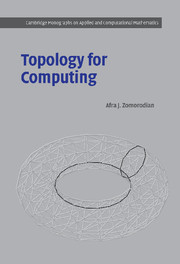8 - Topological Simplification
Published online by Cambridge University Press: 19 August 2009
Summary
In Chapter 6, we motivated the definition of persistence by the need for intelligent methods for topological simplification. In this chapter, we look at algorithms for simplifying a space topologically, using persistence as a measure. We begin by reviewing prior work and formalizing a notion of topological simplification within the framework of filtrations in Section 8.1. We then look at a simple algorithm for computing persistent Betti numbers, which motivates the reordering algorithms for simplification in Section 8.2. There are conflicts, however, between the goals established for simplification. We formalize these conflicts, and discuss their resolution or diminution in Section 8.3. To view the entire persistent history of a filtration, we develop color maps in Section 8.4. We end this chapter with visualizations of simplified complexes.
Motivation
Topological issues arise in surface reconstruction and mesh optimization. Surface reconstruction is, by itself, a topological question, but it is often addressed with geometric methods. Consequently, fast ad-hoc heuristics for surface reconstruction usually give rise to defective surfaces, requiring hole-filling or filtering as a post-processing step (Curless and Levoy, 1996; Turk and Levoy, 1994). Furthermore, surface modification methods such as decimation, refinement, thickening, and smoothing may cause changes in the surface's topology. We gave an example of this connection in the discussion in Section 1.2.3 in relation to surface decimation.
- Type
- Chapter
- Information
- Topology for Computing , pp. 148 - 160Publisher: Cambridge University PressPrint publication year: 2005



